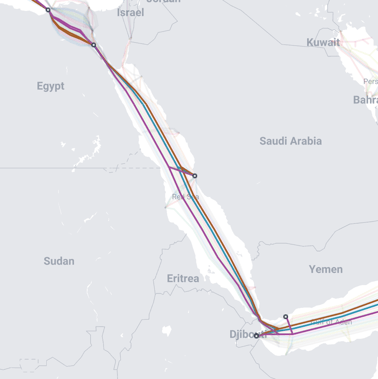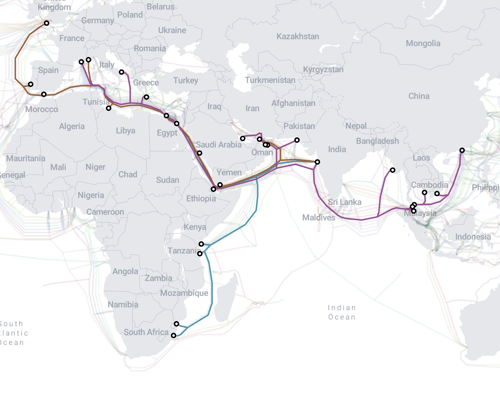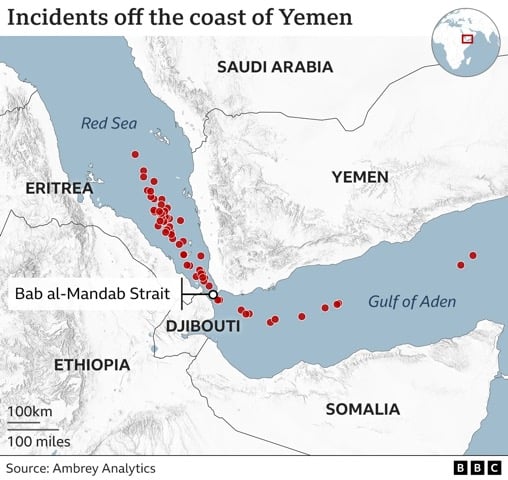We recently wrote about how Houthi attacks in the Red Sea are causing headaches for the undersea cable industry.
Since then, the industry has suffered three cable faults in the region.
What do we know?
On Saturday, February 24, three different cables were reported to have suffered faults:
These international systems connect far-apart states like South Africa, the United Kingdom, and China.
It's worth noting that SEACOM and Tata TGN-Eurasia are two different names for the same cable. This is why some accounts have erroneously reported four, instead of three, cable faults.

 A broader view of the overall path of the impacted cables.
A broader view of the overall path of the impacted cables.What caused the damage?
We're now seeing reports that a ship dragging an anchor was likely to blame.
If so, that wouldn’t be surprising — accidents with ship anchors account for the second most common cause of submarine cable faults.
Were the Houthis to blame?
The decade-long civil war in Yemen recently returned to public focus following a string of attacks on commercial shipping vessels in the Red Sea. Public speculation has also wondered whether, given the concentration of submarine cables off the Yemeni Coast, these systems may become Houthi targets as well.

Immediately after the triple cable faults, some news reports irresponsibly attributed the faults to direct action by the Houthis without citing necessary evidence.
Since then, no open-source evidence has come out to support that claim. But here’s one thing we do know: accidents happen all the time. On average, two cables suffer faults somewhere in the world every week!
Aren't three nearly simultaneous cable faults suspicious?
Not particularly.
Geological features or permitting issues have occasionally forced installers to lay different cables in close proximity to each other.
That situation increases the danger of a multi-cable fault. In 2012, multiple cables suffered faults off the coast of Alexandria, Egypt. Initial speculation blamed saboteurs, but many in the submarine cable industry now believe that a single ship dragging its anchor was the cause.
Very often in these cases, the boring, prosaic reason turns out to be the culprit.
Is it time to panic?
No. These Red Sea cables are important: 90% of Europe-Asia communications flow through them. However, operators have built a lot of redundancy into the network.
There are 14 cables already laid on the Red Sea. Even if three are down, 11 remain. Data destined for damaged cables may be rerouted southward around the Cape of Good Hope or eastward through Asia and the United States.
That said, no matter the exact cause of the cable faults, Houthi attacks on surface ships do present real challenges to the undersea cable industry.
Vessels that are sinking or sunken present new underwater hazards to cables and cable ships. Also, shipping attacks have caused marine insurance rates to spike.
Combined, these second-order effects of Houthi attacks may make the installation of new cables in the Red Sea too prohibitive, and certainly make repair risky.
What can governments do?
There’s been lots of reporting on naval efforts to protect the freedom of navigation in the Red Sea.
Looking longer-term into subsea cable security, there’s quite a bit governments can do. (The International Cable Protection Committee has a succinct list of action items.)
One priority: changing rules to open up new seabed lanes and landing zones for cables. Some government regulations (such as environmental protection) may unintentionally herd cables into narrow corridors. As we’ve seen time and time again, a lack of physical diversity invites disaster.
Tim Stronge
Tim Stronge is Chief Research Officer at TeleGeography. His responsibilities span across many of our research practices including network infrastructure, bandwidth demand modeling, cross-border traffic flows, and telecom services pricing.





